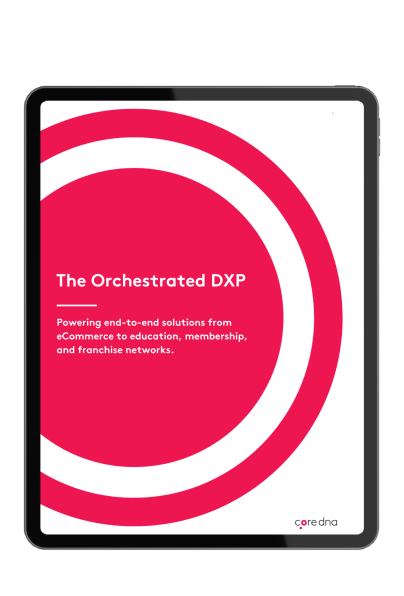From Joomla to SaaS: How Codus Gained Control With Core dna

For over a decade, Joomla CMS has been a trusted open-source CMS with an active developer community and stable architecture. It offered flexibility, extensibility, and control, but as the web evolved, maintaining that control came at a growing cost.
So like many businesses that built their sites years ago on Joomla CMS, CODUS found themselves stuck.
Their website was built on an older version that had reached end-of-life, meaning no more security patches, updates, or support. When they tried to upgrade, they discovered what every Joomla user eventually learns: moving from one major version to another isn’t a simple update, it’s a full rebuild. For CODUS, this meant higher maintenance costs, limited access, and constant technical uncertainty.
The team faced several issues common to open-source CMSs and like many open-source projects, the economics had changed.
Key takeaways
- For mid-sized businesses without in-house developers, open-source CMS platforms like Joomla quickly turn into hidden cost centers requiring constant maintenance and agency support.
- Core dna’s managed SaaS CMS eliminates upgrades, rebuilds, and hosting headaches, providing a continuously improving system that just works.
- With Core dna, marketing teams can create, edit, and launch content on their own, no developers, no delays, no tickets. \
- Native orchestration and AI features automate SEO, forms, and workflows, saving Codus time and effort across every task.
- It’s a Strategic Shift, Not Just a Migration: Moving from open source to SaaS transforms digital operations from reactive maintenance to proactive growth and innovation.
On this page:
The tipping point for Codus
As many mid-sized businesses with limited in-house tech , their website platform wasn’t chosen strategically, it was chosen for them.
An agency recommended Joomla CMS, built the site, and managed everything from hosting to updates.
At first, that setup worked. But over time, the very thing that was meant to provide freedom "open source" became a point of dependence.
Codus' website was also entirely by an external agency, meaning they couldn’t make simple edits without developer help.
Without in-house technical resources, every update, plugin change, or version upgrade meant another invoice and another waiting period. And when Joomla 3 reached end-of-life, businesses like Codus faced an all-too-familiar choice: pay again for a full rebuild on Joomla 4 then Joomla 5, or break free from the cycle altogether.
Classic Questions When Moving Away from Joomla
- Do we want to keep paying for version upgrades every few years or invest in a platform that upgrades itself?
- Do we still need to self-host, or can we trust a managed cloud platform to handle security, performance, and backups?
- Are our third-party extensions and templates sustainable, or will we face new license and compatibility costs with every update?
- Can our internal team update and evolve the site on their own, or are we permanently reliant on outside developers?
- How much risk can we tolerate if a future update breaks the site or our plugins stop being maintained?
These questions made the choice clear. Codus didn’t just need a new version, they needed a new model.
That’s what led them to Core dna
They wanted a platform that eliminated rebuilds and compatibility checks altogether, allowed marketing and communications teams to manage content directly without relying on developers, integrated with their internal tools for workflow automation, provided predictable, all-inclusive pricing and a platform that could evolve with AI-driven capabilities instead of requiring bolt-ons and custom patches.
The Solution: Moving to a Fully Managed SaaS CMS Platform
“We hadn’t done a lot of changes in the last year because Joomla was toocomplex. This will make it so much easier.”
Migrating to Core dna gave Codus a fresh start without losing their content, structure, or brand consistency.
With Joomla, every major version meant reworking templates, extensions, and hosting environments. Core dna removed that problem entirely.
There’s only one version of the platform, no upgrades to manage, no migration paths to plan. Every customer runs on the same continuously improved SaaS infrastructure, receiving new features and security patches automatically.
Core dna’s modular architecture replaces the patchwork of third-party extensions with native tools.
Pages, forms, SEO, content blocks, integrations, and workflows all live in one system, each maintained by Core dna, not external developers.
Under the hood, orchestration handles the heavy lifting: data synchronization, API connections, and background automations that keep everything running smoothly. Codus can now trigger workflows like sending form submissions to Teams or Smartsheet.
And because the platform is component-based, their marketing team can reuse global modules (like “Projects Made Possible” or “Featured Team”) across pages.
A single edit updates everywhere eliminating duplicate work and human error.
Core dna’s built-in revision history and rollback features also gave them peace of mind. If something goes wrong, they can instantly revert to a previous version of a page with one click.
Finally, the platform’s AI-driven capabilities simplify day-to-day operations. Codus no longer has to manually write metadata or alt text, Core dna automatically generates optimized SEO tags as content is created.
What did Codus earn from moving to Core dna?
For many mid-sized businesses, the shift from an open-source CMS to a SaaS platform marks a turning point. They moved from a situation that was all about maintaining technology to one of mastering it.
Open source once promised freedom, flexibility, and control. But for companies without dedicated IT teams, that freedom often becomes a full-time job. Every upgrade demands testing, every plugin introduces risk, and every change requires outside help.
Over time, what began as an affordable solution turns into an invisible cost center consuming time, budgets, and energy that should be spent on customers, not code.
A SaaS CMS like Core dna changes that equation entirely. It removes the layers of technical debt that accumulate with open-source systems: the hosting dependencies, version upgrades, and plugin maintenance and replaces them with continuous, managed evolution.
There’s no “next version” to migrate to, no rebuild waiting on the horizon. Instead, updates, security, and performance improvements happen automatically in the background.
For marketing and communications teams, that shift is transformative. They move from asking developers for help to owning the experience themselves. Launching a new page, embedding a form, or automating SEO becomes as simple as clicking “publish".
And because orchestration and automation are built into the platform, workflows that once required integrations or custom scripts now run natively connecting websites, CRMs, and collaboration tools with zero friction.
In other words, moving to a SaaS CMS isn’t just about simplifying technology. It’s about unlocking independence. It gives mid-sized businesses the ability to evolve faster, deliver better digital experiences, and scale without technical bottlenecks.
Codus’ journey from Joomla to Core dna is one example of that evolution. But their story reflects a much larger truth: when mid-sized businesses stop maintaining open-source systems and start embracing managed platforms, they don’t lose control.
The Comparison: Joomla vs Core dna
For small business, open-source platforms like Joomla once felt like the perfect balance of freedom and affordability. But as companies grow into the mid-market, that freedom often turns into friction. Every version upgrade demands developer hours. Every plugin update risks breaking something. And every year brings new costs, hosting, maintenance, and rebuilds just to stay supported.
For mid-sized organizations with lean teams and complex needs, this model becomes unsustainable. Instead of focusing on growth and customer experience, teams get trapped maintaining a patchwork of extensions and dependencies.
That’s where Core dna changes the equation. It gives mid-sized businesses enterprise-grade control without the burden of open-source maintenance a unified, SaaS-based platform that handles security, upgrades, and orchestration automatically, so teams can focus on building, not fixing.
Codus’ journey from Joomla to Core dna is a clear example of this shift from maintaining a system to mastering one.
What It Means to Move from Open Source to a SaaS CMS
For many mid-sized businesses, the shift from an open-source CMS to a SaaS platform marks a turning point. They move from maintaining technology to mastering it.
Open source once promised freedom, flexibility, and control. But for companies without dedicated IT teams, that freedom often becomes a full-time job. Every upgrade demands testing, every plugin introduces risk, and every change requires outside help.
Over time, what began as an affordable solution turns into an invisible cost center, consuming time, budgets, and energy that should be spent on customers, not code.
A SaaS CMS like Core dna changes that equation entirely. It removes the layers of technical debt that accumulate with open-source systems, the hosting dependencies, version upgrades, and plugin maintenance and replaces them with continuous, managed evolution.
There’s no “next version” to migrate to, no rebuild waiting on the horizon. Instead, updates, security, and performance improvements happen automatically in the background.
For marketing and communications teams, that shift is transformative.
They move from asking developers for help to owning the experience themselves. Launching a new page, embedding a form, or optimizing for SEO becomes as simple as clicking “publish.”
And because orchestration and automation are built into the platform, workflows that once required integrations or custom scripts now run natively connecting websites, CRMs, and collaboration tools with zero friction.
In other words, moving to a SaaS CMS isn’t just about simplifying technology. It’s about unlocking independence.
It gives mid-sized businesses agility to evolve faster, deliver better digital experiences, and scale without technical bottlenecks.
CODUS’s journey from Joomla to Core dna is one example of that evolution.
But their story reflects a much larger truth: when mid-sized businesses stop maintaining open-source systems and start embracing managed platforms, they don’t lose control.
Joomla remains a strong platform for developers who want full control and don’t mind ongoing maintenance. But for mid-sized businesses like Codus, who need to move fast, stay secure, and keep costs predictable, the SaaS model is a smarter long-term fit.
With Core dna, they no longer have to worry about what version of MySQL or PHP their hosting supports, or whether the next upgrade will break their site.
They can simply focus on building better digital experiences.
From open-source maintenance to managed simplicity, that’s the Core dna difference.





